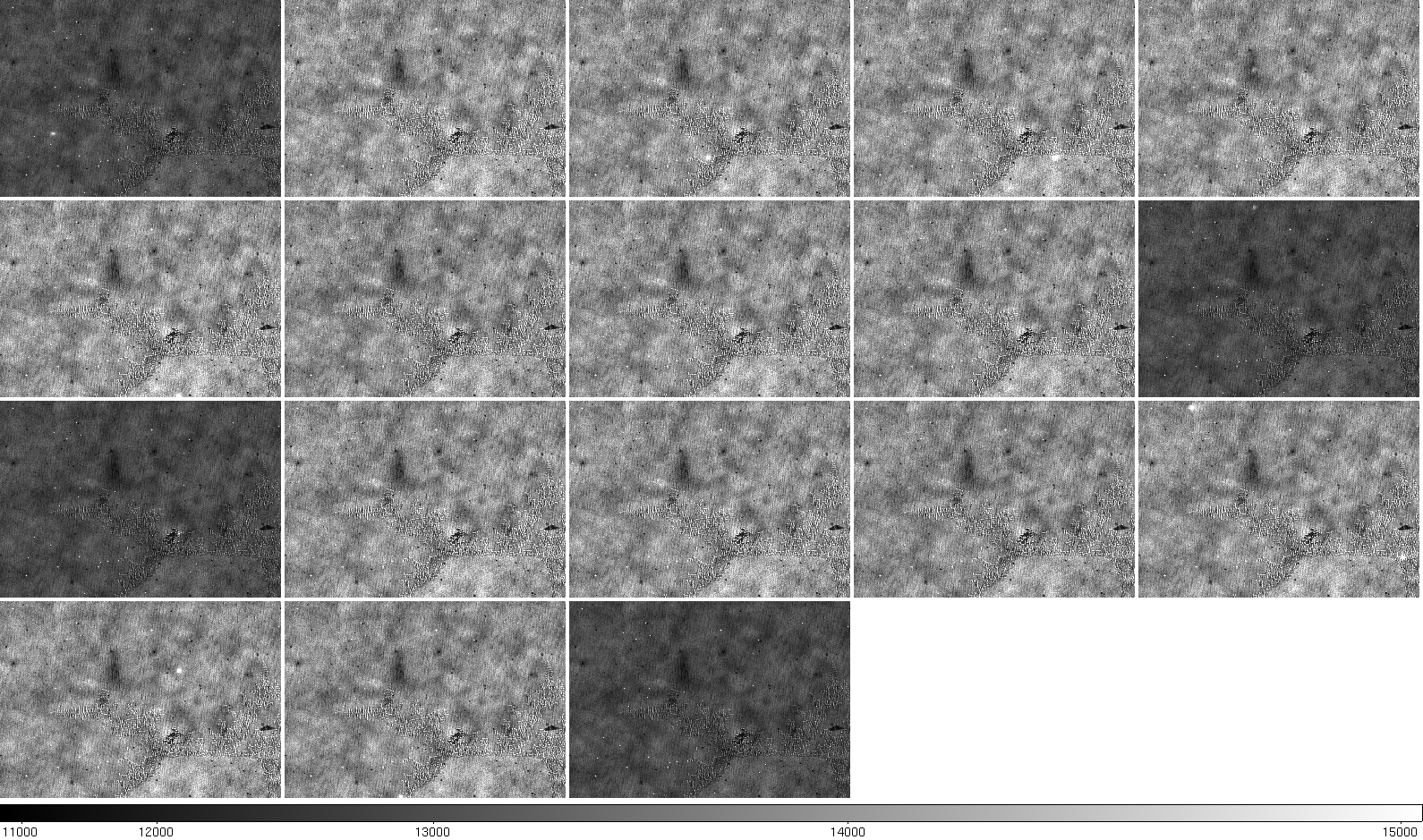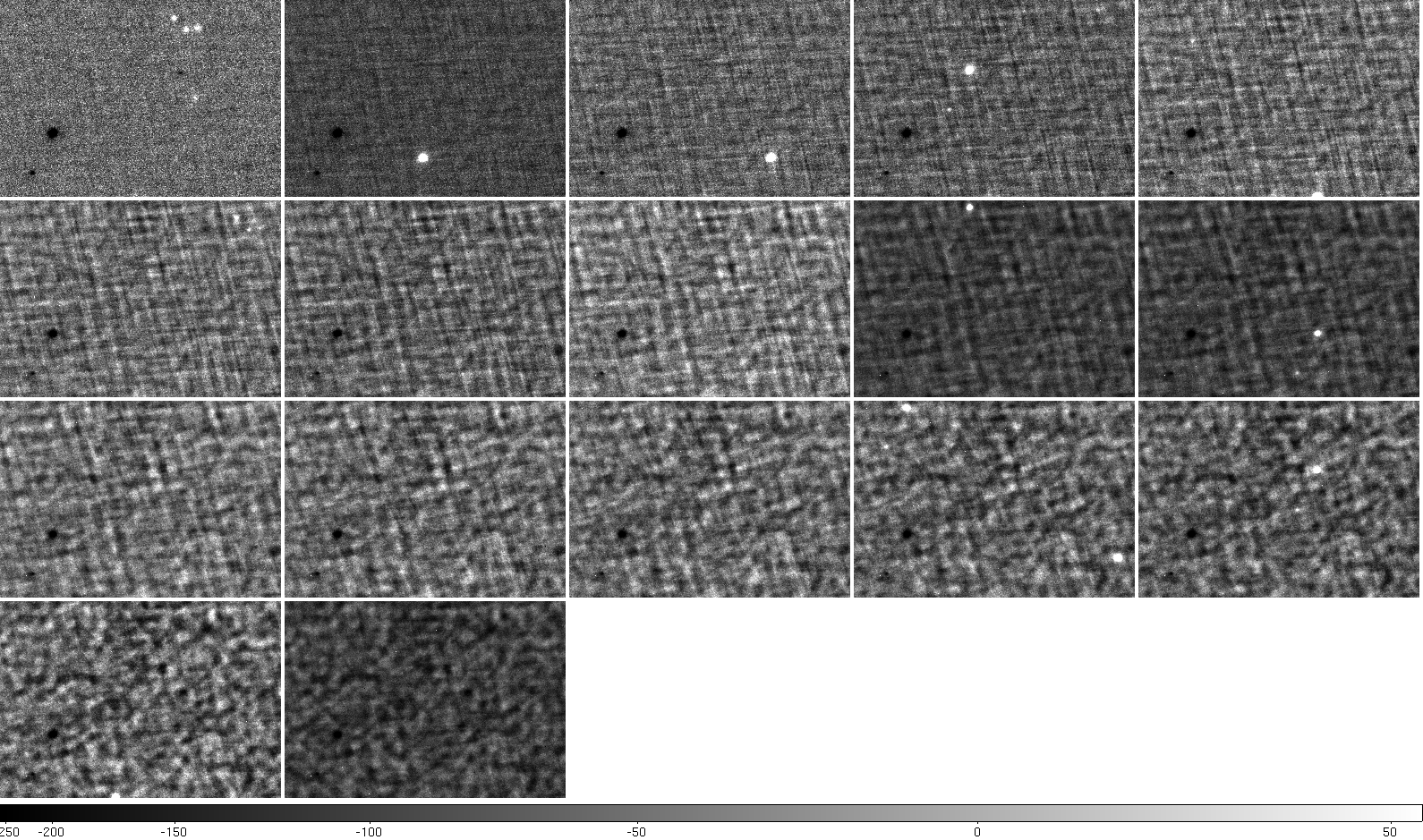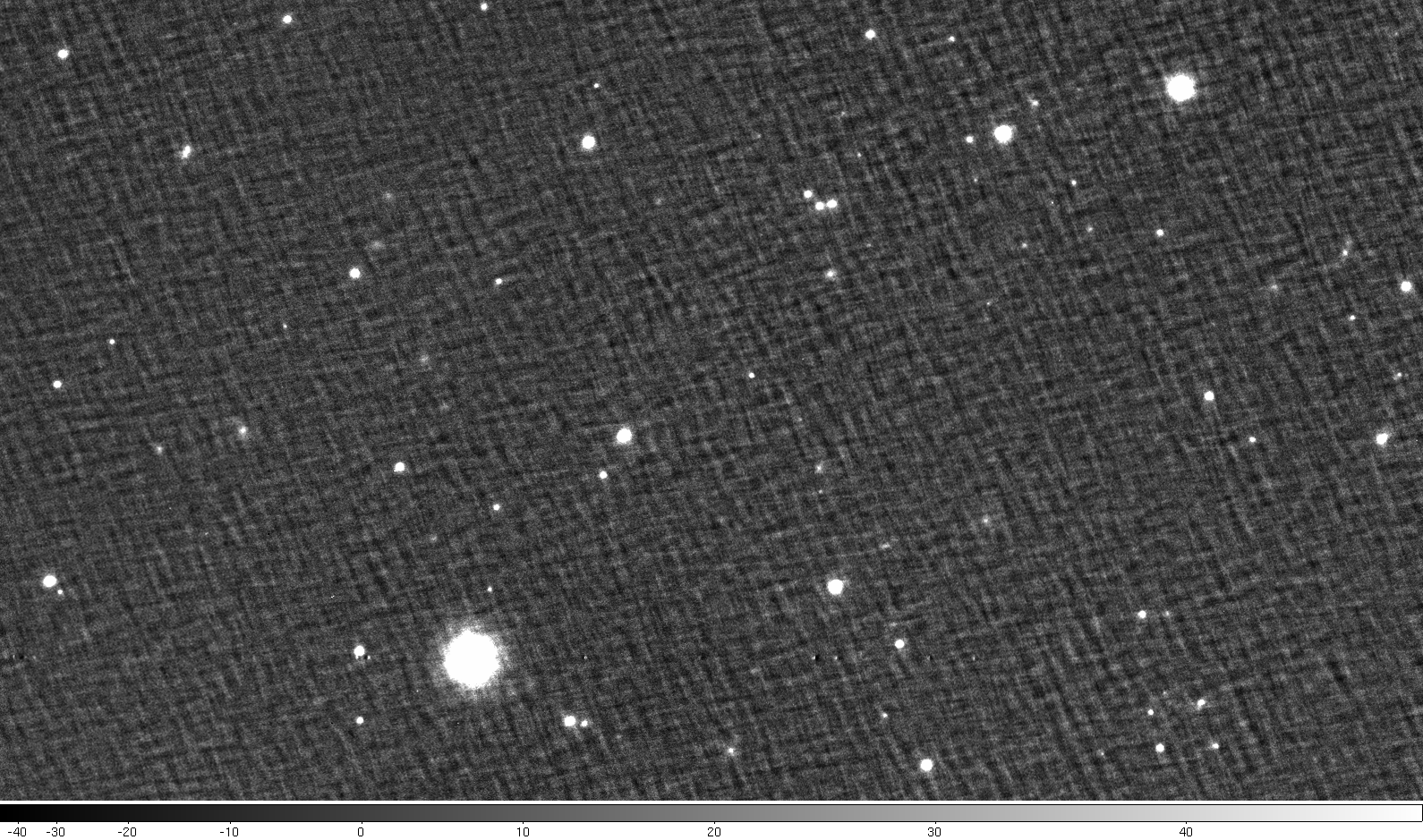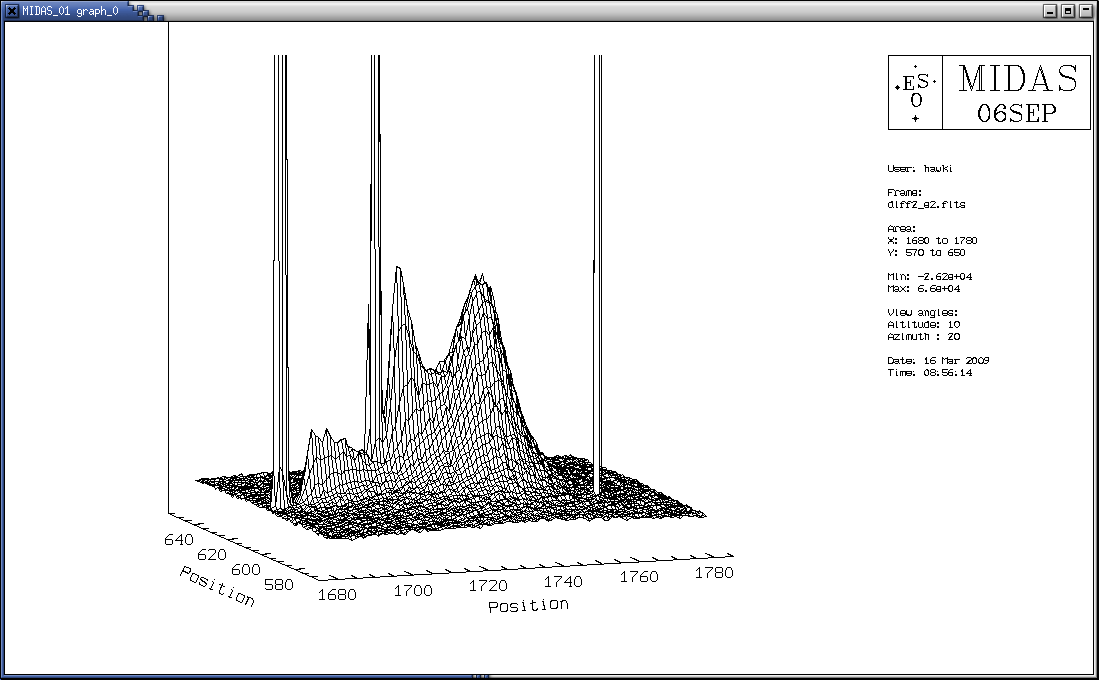 mirror sites:
PL (internal link)
HQ
[?]
mirror sites:
PL (internal link)
HQ
[?]
Quality Control and
Data Processing
|
HAWKI: Issues and Features
HAWK-I detectors' related ISSUES and FEATURES HAWK-I was commissioned during Periods 79 and 80 and then began operations at the start of P81. Since then it has sufferred to varying degrees from several problems which afect the quality of the data. This page summarizes these problems. Details are provided in spearate web pages. They are linked from this page. For further description of problems/features visit the History section of the plot_tutorial pages.
All data to date...
Some of the data...
The minimum Detector Integration Time
The minimum Detector Integration Time [DIT] is determined by the
configuration of the electronics of the detector system.
Eliminating Crosstalk: 2009-05-07
After approximately one year of operations and feedback from the user
community, in order to address concerns regarding Crosstalk (see
below) the confguration of the electronics was adjusted with three
consequences:
Before 2009-05-07T21:30 it was:
From 2009-05-07T021:30 on it is:
Pupil Ghosts
Between the last Commissioning/Science Verification run (which
ended January 30th) and the start of operations in P81 (Apr-Sep 2008),
the entrance window to the instrument
cryostat suffered a significant degradation and operations
began in less than optimum conditions. The problem was
resolved during an intervention conducted 2008-08-20 --
2008-08-24.
All data acquired between 2008-04-01 and 2008-08-20 are
affected by this problem, though to what degree generally
depends on the circumstances of the observations, though often
in an apparently random way...
During the Aug intervention it was discovered that the
entrance window degradation was caused by a greasy film. The
greasy film is believed to have been deposited during the
3 month period between the end of Commissioning/Science
Verification and the start of observations when, for technical
reasons, HAWK-I was kept under vacuum but at room
temperature, instaed of it's usual cryogenically cooled state.
The degradation caused TWO effects to be evident in reduced
SCIENCE data:
Example data from April 2008 where the Pupil Ghost pattern
and the effects of a 'sudden lateral shift' are clearly present
[AB =
HAWKI.2008-04-29T02:47:25.267_tpl.ab]:
Radiation-Induced Charge Collection
As reported on 04/06/2007 in the HAWKI Test report on the Detector and Acquisition System (VLT-TRE-ESO-14800-4062)
detector with DET.CHIP.NO = 2 ( DET.CHIP.ID = ESO-Hawaii2RG-chip78 ) is subject of radioactive events.
Here we report on the number and the character of the radiation-induced charge collections.
The following data have been analysed:
Fig.1 Difference of two DIT=300sec raw dark frames taken on 2009-02-20.
Fig.2: Shape of the strongest event with 730 ADU peak counts.
Fig. 4: Details of a difference between two consecutive dark frames (DIT=300, NDIT=1)
showing several weak events. Summary:
From the events total flux, three frequently occuring types of events can be distinguished:
Events can show up in any kind of shape from circle-like, ellipsoide,
comet-like up to 400 pixel long narrow trails.
There is no prefered orientation of the trails (derived by visual inspection).
The number of events is linearly increasing with DIT (exposure time) ,
The event rate is is about 13 events per minute.
The event rate is constant within the last 8 months.
The large number of diffuse events with highly elongated shape which are so far
homogeneously distributed over chip #2 with uncorrelated trajectory orientations gives rise to the
suggestion that the radioactive source itself is close to the detector plan, and that the source
is extended.
The few particle trajectories derived from the two neighboring chips #1 and #3 do not point
to chip #2. This is interpreted in the way that the radiation registered on chip #1 is not emitted
from chip #2, but emitted in the same way from a source layer in chip #1 with a much smaller
event rate of < 1 event per minute. The same holds for chip #3. Chip #4 does not show any
stochastic events of this kind.
For a DIT=300 NDIT=1 dark or science exposure, chip #2 registers about 65 events.
No detailed distribution of the event characteristics like flux, shape, position is availabale.
The ESO HAWKI data reduction pipeline does not correct for these events.
Central Flare-like Feature
The Central Flare-like Feature appears and disappears
intermittently, usually for a period of some months at a time.
The following periods clearly have the feature:
At the centre of the array, i.e. where the four chips meet,
there is a "flare-like" structure. It becomes evident in frames with
DIT greater than about 30sec.
The presence of the feature is monitored in the 60 and 300 sec
Daily Health Check [DHC] DARK frames.
The following images are montages of the central regions of the the
300 sec DHC DARK frames: |
||||||||||||||||||||||||||||||||||||||||||||||||||||||||||||||||||||||||||||||||||||||||||||||||||||||||||||||||||||||||||||||||||||||||||||||||||||||||||||||||||||||||||
| |
|||||||||||||||||||||||||||||||||||||||||||||||||||||||||||||||||||||||||||||||||||||||||||||||||||||||||||||||||||||||||||||||||||||||||||||||||||||||||||||||||||||||||||
 |
|
||||||||||||||||||||||||||||||||||||||||||||||||||||||||||||||||||||||||||||||||||||||||||||||||||||||||||||||||||||||||||||||||||||||||||||||||||||||||||||||||||||||||||







![[ 2008-04-27 -- 2008-09-27 ]](../img/hawki_FlareMonIm_2008-04-27_2008-09-27_tn.png)
![[ 2008-09-28 -- 2008-12-02 ]](../img/hawki_FlareMonIm_2008-09-28_2008-12-02_tn.png)
![[ 2008-12-03 -- 2009-02-16 ]](../img/hawki_FlareMonIm_2008-12-03_2009-02-16_tn.png)
![[ 2009-02-17 -- 2009-05-03 ]](../img/hawki_FlareMonIm_2009-02-17_2009-05-03_tn.png)
![[ 2009-05-04 -- 2009-07-05 ]](../img/hawki_FlareMonIm_2009-05-04_2009-07-05_tn.png)
![[ 2009-07-06 -- 2009-09-18 ]](../img/hawki_FlareMonIm_2009-07-06_2009-09-18_tn.png)
![[ 2009-09-19 -- 2009-12-08 ]](../img/hawki_FlareMonIm_2009-09-19_2009-12-08_tn.png)
![[ 2009-12-08 -- 2010-02-13 ]](../img/hawki_FlareMonIm_2009-12-08_2010-02-13_tn.png)
![[ 2010-02-14 -- 2010-04-25 ]](../img/hawki_FlareMonIm_2010-02-14_2010-04-25_tn.png)
![[ 2010-04-26 -- 2010-07-08 ]](../img/hawki_FlareMonIm_2010-04-26_2010-07-08_tn.png)
![[ 2010-07-09 -- 2010-09-16 ]](../img/hawki_FlareMonIm_2010-07-09_2010-09-16_tn.png)
![[ 2010-09-17 -- 2010-12-11 ]](../img/hawki_FlareMonIm_2010-09-17_2010-12-11_tn.png)
![[ 2010-12-12 -- 2011-02-22 ]](../img/hawki_FlareMonIm_2010-12-12_2011-02-22_tn.png)
![[ 2011-02-23 -- 2011-04-24 ]](../img/hawki_FlareMonIm_2011-02-23_2011-04-24_tn.png)